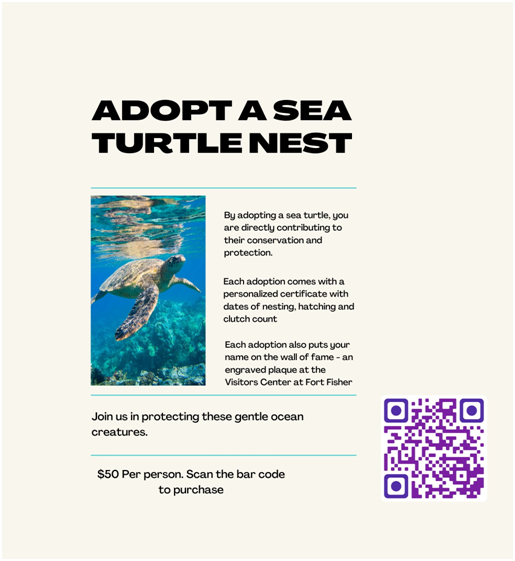
Please scan the QR code to adopt.
ADOPT A SEA TURTLE NEST
Fort Fisher State Recreation Area was the site of 85 Loggerhead Sea Turtle nests with over 6,000 hatchlings in the 2023 season. Nest adoption shows your commitment to the protection of this endangered species.
Adoption is $50 per person, which includes a certificate denoting information about your nest and your name on the Sea Turtle Adoption Plaque hung in the Visitors Center at Fort Fisher as a community conservationist.
Deadline for 2023 is December 31, 2023

DNA Analysis
The Fort Fisher Sea Turtle Monitoring Program participates in the Loggerhead Sea Turtle Genetics Project with the Northern Recovery Unit (NRU), which consists of Sea Turtle Monitoring programs from Georgia to Virginia.
Project Need: The loggerhead sea turtle is an endangered species that serves as an indicator of the ecosystem health in open ocean and coastal habitats. The number of loggerheads in the southeastern US declined dramatically from human related activities such as commercial fishing and negative impacts to their nesting beaches. After decades of nest protection and the implementation of turtle excluder devices in shrimp trawl nets, the annual number of nests has increased from its lowest point in 2004 along with a decrease in the number of adult turtles drowning in shrimp nets. However, nest numbers are still below historic levels.
Project Activities: Counting nests provides clues about how many mother turtles there are in the population, but alone does not provide the nesting histories of individual females that are needed for accurate population models. Since 2008, DNA markers have been used to identify individual loggerhead turtles from an egg sample. Since 2010, nesting histories have been developed for all known loggerhead nests in Georgia, SC and NC.Nesting history is critical to management and population recovery.
Expected Benefits: Many important questions remain unanswered. Because loggerhead turtles take decades to mature and live a long time, estimating female survival, new female recruitment, age of maturity, and how long they reproduce require long term data collection. About 25-35% of the females in recent years are new females we assume are nesting for the first time –each year this percentage is increasing.
Our goal is to continue this research until analysis reveals a majority of new nesting females are daughters of a mother who we know has nested previously. In addition, new aging techniques will make it possible to estimate the age of the loggerhead from a genetics sample.
It is critical that we keep collecting samples at the same sites, without any gaps in space or time, to ensure accurate estimate of age at sexual maturity and reproductive life span.
All donations are welcomed and are forwarded directly to the Northern Recovery Unit for continued DNA analysis.

Please scan the QR code for donations.
